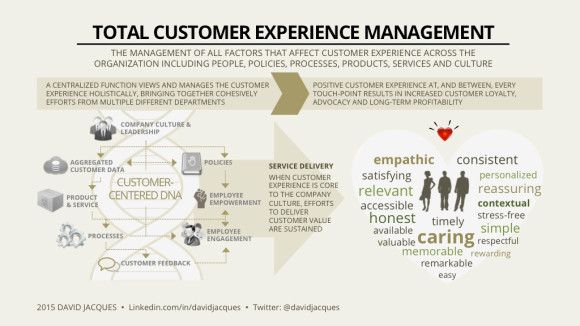Building a Customer Experience Management Practice
This is a summary of the article “Guide to Customer Experience Transformation and Management” originally posted on LinkedIn on 30 April 2015.
Understanding that customer experience is linked to customer loyalty and profitability, many organizations are looking at enhancing their customer experience management capabilities.
The article provides a high-level action plan to make tangible customer experience improvements in the short and medium term while building a sustainable customer experience management practice.
First and foremost, it requires customer experience to be core to the organization’s strategy and a commitment by leadership to building long-term profitability through customer loyalty and advocacy.
Defining customer experience management
Customer experience management is not software or an individual project; it is the ongoing management all aspects that affect customer experience across the organization including people, policies, processes and culture.
Requires a dedicated function
Many of the factors that affect customer experience are managed by different departments including marketing, operations, sales, service, IT and HR. Total customer experience management requires putting in place a dedicated function whose responsibility is to view the customer experience holistically and bring together cohesively initiatives from multiple different departments. Some organizations have called this function the Chief Customer Officer or Head of Customer Experience.
Identify and Prioritize CEM Initiatives
The first step is to conduct a complete assessment of the current customer experience and management capabilities thereof.
This is called a “customer experience management audit”. It includes analyses of:
- The total customer experience from the customers’ perspective
- Internal processes
- Information systems capabilities and usage
- High-level cost benefit of improvement opportunities
- Company culture and employee engagement
The result of the audit will help create a roadmap for transformation and prioritize initiatives on multiple levels. Below are the broad areas in which these initiatives will start in parallel.
Start with Quick Wins
Quick wins are low-cost, quickly implementable initiatives that have the highest impacts on business and on the customer experience. There are practical reasons to start with quick wins:
- Being lower cost and easier to implement means they are easier to accept by different parties involved (less resistance)
- Seeing positive results faster helps build buy-in for other, perhaps more involving, initiatives
Fix issues first
Organizations should strive to differentiate from the competition with positive customer experiences that wow the customers. But priority should be given to fixing the biggest sources of current customer dissatisfaction and churn. Without fixing biggest issues first, investments in new positive experiences risk being wasted.
Build Bridges Between Departments
In most companies, customer experience is managed in organizational silos. Facilitating customer experience improvements in the short and long term will require building cross-departmental collaboration models. The following approach is recommended:
- Build a common view of the total customer experience: Customer journey maps will help everyone have a common understanding of how individual interactions fit the in the broader customer journey.
- Define direct and indirect roles and responsibilities: Build a matrix illustrating how everyone contributes to the customer experience from marketing and customer service to IT and HR
- Involve all affected parties in planning initiatives: When planning customer experience improvement strategies or tactics, bring everyone involved or affected at the table to build acceptance and mitigate risk.
- Build a matrix management structure: For ongoing collaboration, build permanent workgroups or a matrix structure made of people from different department around specific customer journeys or the total customer experience.
Information Management: Aggregate Data
There is often a lot of valuable information about the customer locked away in organizational silos including customer feedback, customer profiles and interaction history. Aggregating data from multiple sources across the organization can help create a more complete picture of the customer, helping deliver a more relevant and personalized customer experience.
Ensure it will actually be used
Technology itself doesn’t improve the customer experience; it is how you use it that does. Before investing in information management enhancements, you have to ensure target users have the capacity and willingness to use the systems to enhance the customer experience.
Culture Change or Reinforcement
The only way to ensure constant and sustained customer experience improvements is making delivering customer value core to the company culture. When customer centricity permeates the organization, improvements to the customer experience happen more organically.
Some initiatives are aimed at building a culture of customer-centricity and making customer experience management sustainable in the long term.
- Clearly articulate company values: Company values have to be clearly articulated and communicated to everyone in the organization.
- Define and measure valued behaviors: Company values must be defined in observable and measureable behavioral terms.
- Motivate or further engage employees: Additional mechanisms can be used to further motivate or engage employees in delivering a better customer experience. These can include using customer feedback, empowering employees to make better decisions or enhancing recruiting and onboarding practices.
For more background and examples on each concept, read the full article on LinkedIn. And please click the “like” icon on the page if you enjoyed it!
David Jacques is Founder and Principal Consultant of Customer input Ltd and a pioneer in the field of Customer Experience Management. He has created the first Framework that brings together cohesively every aspect of Customer Experience Management. He is also passionate about having an in-depth understanding customer values to create emotionally-engaging customer experiences not only at individual interactions but also seamlessly between them.
All posts by David (30) - Connect on: LinkedIn - Twitter

